1980–81 South Pacific cyclone season
The 1980–81 South Pacific cyclone season was an above-average season.
| 1980–81 South Pacific cyclone season | |
|---|---|
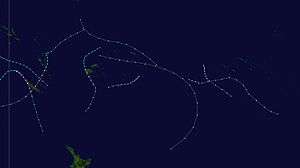 Season summary map | |
| Seasonal boundaries | |
| First system formed | November 27, 1980 |
| Last system dissipated | March 21, 1981 |
| Strongest storm | |
| Name | Freda |
| • Maximum winds | 150 km/h (90 mph) (10-minute sustained) |
| • Lowest pressure | 955 hPa (mbar) |
| Seasonal statistics | |
| Total depressions | 12 |
| Tropical cyclones | 11 |
| Severe tropical cyclones | 4 |
| Total fatalities | Unknown |
| Total damage | Unknown |
| Related articles | |
Seasonal summary
This season marked the first time that the United States Joint Typhoon Warning Center issued warnings and performed best track analysis on significant tropical cyclones in the Southern Hemisphere.[1]
Systems
Tropical Cyclone Diola
| Category 1 tropical cyclone (Australian scale) | |
| Tropical storm (SSHWS) | |
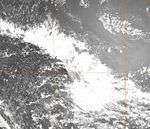  | |
| Duration | November 27 – November 30 |
|---|---|
| Peak intensity | 65 km/h (40 mph) (10-min) 990 hPa (mbar) |
Diola existed from November 27 to November 30.
Severe Tropical Cyclone Arthur
| Category 3 severe tropical cyclone (Australian scale) | |
| Category 1 tropical cyclone (SSHWS) | |
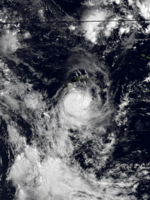  | |
| Duration | January 11 – January 17 |
|---|---|
| Peak intensity | 130 km/h (80 mph) (10-min) 965 hPa (mbar) |
Arthur existed from January 11 to January 17.
Tropical Cyclone Betsy
| Category 1 tropical cyclone (Australian scale) | |
| Tropical storm (SSHWS) | |
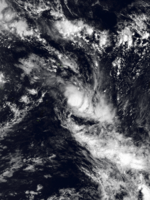  | |
| Duration | January 30 – February 4 |
|---|---|
| Peak intensity | 65 km/h (40 mph) (10-min) 995 hPa (mbar) |
Betsy existed from January 30 to February 4.
Severe Tropical Cyclone Cliff
| Category 3 severe tropical cyclone (Australian scale) | |
| Category 1 tropical cyclone (SSHWS) | |
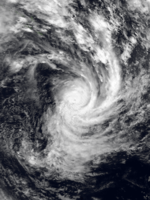  | |
| Duration | February 8 – February 13 (Crossed 160°E) |
|---|---|
| Peak intensity | 120 km/h (75 mph) (10-min) 970 hPa (mbar) |
After ravaging the South Pacific islands, Cyclone Cliff struck Queensland on February 14. The effects of the cyclone was felt from Noosa to Burleigh Heads on the Gold Coast. One person died in the storm.[2]
Tropical Cyclone SP198006
| Category 2 tropical cyclone (Australian scale) | |
  | |
| Duration | February 16 – February 21 |
|---|---|
| Peak intensity | 95 km/h (60 mph) (10-min) 985 hPa (mbar) |
This cyclone existed from February 16 to February 21.
Tropical Cyclone Daman
| Category 2 tropical cyclone (Australian scale) | |
| Tropical storm (SSHWS) | |
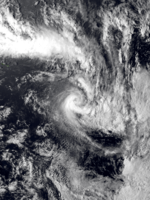 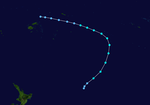 | |
| Duration | February 20 – February 24 |
|---|---|
| Peak intensity | 100 km/h (65 mph) (10-min) 980 hPa (mbar) |
Daman existed from February 20 to February 24.
Tropical Cyclone SP198008
| Category 1 tropical cyclone (Australian scale) | |
| Tropical storm (SSHWS) | |
 | |
| Duration | February 22 – March 7 |
|---|---|
| Peak intensity | 75 km/h (45 mph) (10-min) 990 hPa (mbar) |
This cyclone existed from February 22 to March 7.
Severe Tropical Cyclone Freda
| Category 3 severe tropical cyclone (Australian scale) | |
| Category 2 tropical cyclone (SSHWS) | |
 | |
| Duration | February 24 – March 9 |
|---|---|
| Peak intensity | 150 km/h (90 mph) (10-min) 955 hPa (mbar) |
Freda existed from February 24 to March 9.
Tropical Cyclone Esau
| Category 2 tropical cyclone (Australian scale) | |
| Tropical storm (SSHWS) | |
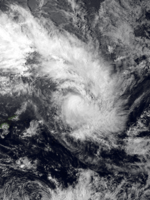  | |
| Duration | March 1 – March 5 |
|---|---|
| Peak intensity | 100 km/h (65 mph) (10-min) 980 hPa (mbar) |
Esau existed from March 1 to March 5.
Severe Tropical Cyclone Tahmar
| Category 3 severe tropical cyclone (Australian scale) | |
| Category 1 tropical cyclone (SSHWS) | |
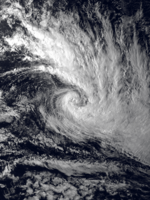  | |
| Duration | March 8 – March 13 |
|---|---|
| Peak intensity | 120 km/h (75 mph) (10-min) 970 hPa (mbar) |
Tahmar existed from March 8 to March 13.
Tropical Cyclone Fran
| Category 2 tropical cyclone (Australian scale) | |
| Tropical storm (SSHWS) | |
  | |
| Duration | March 17 – March 24 |
|---|---|
| Peak intensity | 95 km/h (60 mph) (10-min) 985 hPa (mbar) |
Fran existed from March 17 to March 24.
Other systems
The JTWC initiated warnings on Tropical Cyclone 12P during January 26, which had moved into the basin from the Australian region during the previous day. The system subsequently passed in between Vanuatu and New Caledonia before it was last noted during January 27.
See also
References
- http://www.dtic.mil/get-tr-doc/pdf?AD=ADA130187
- "Noosa to Burleigh Heads, Qld: Cyclone (incl. Storm Surge)". Archived from the original on 2007-10-26. Retrieved 2013-07-06.